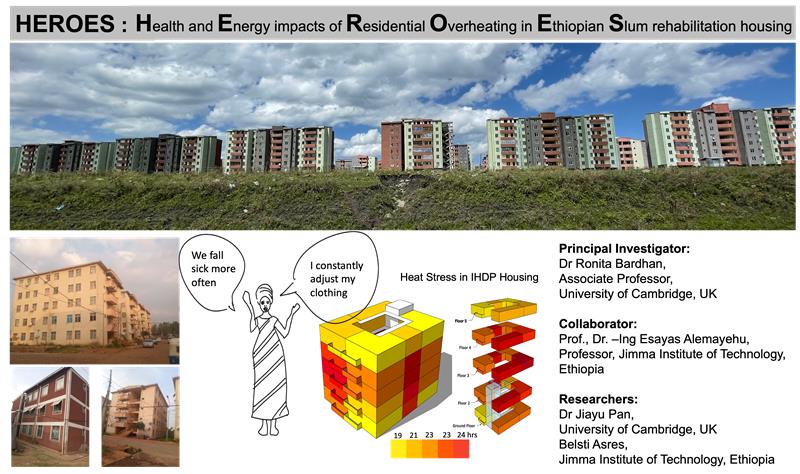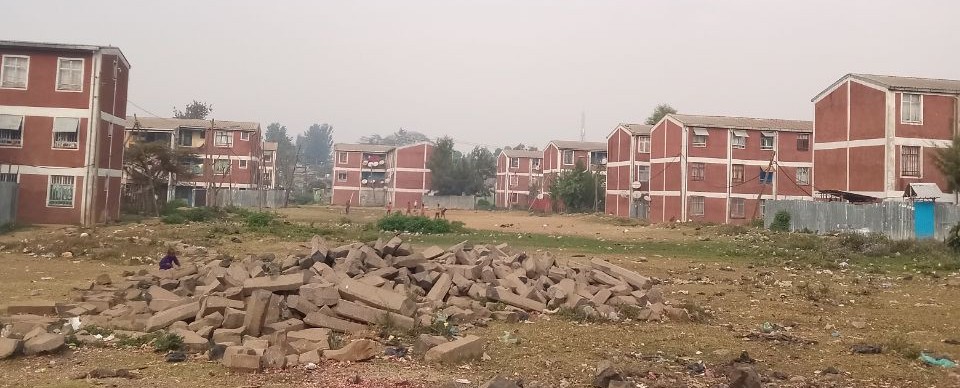HEROES in Action: Understanding Residential Overheating in Integrated housing Development Programme with a Case Study in Jimma, Ethiopia

Written by Dr Ronita Bardhan and Dr Jiayu Pan, Cambridge Sustainable Design Group
Human being are indoor species. They spend more than 90% of their time indoors and more so in domestic spaces like homes. This situation coupled with global climate warming demands heat resilient homes, especially in resource constraint settings where access to cooling solutions are stringent. The rise of urbanisation has resulted in a deluge of housing crises for affordable housing are the most inevitable solution. However, these affordable or social housing seldom warrant thermal comfort. In Ethiopia, the Integrated Housing Development Programme (IHDP) represents a significant effort to address the urban housing crisis. However, these affordable housing solutions are often implemented with minimal consideration of indoor environmental quality, which directly impacts the health, energy use and well-being of occupants.
The HEROES project (‘ Health and Energy impacts of Residential Overheating in Ethiopian Slum rehabilitation housing’ ) supported by Cambridge-Africa ALBORADA Research fund, led by Dr Ronita Bardhan from University of Cambridge, UK in collaboration with Professor Esayas Alemayehu from Jimma University, Ethiopia undertook a comprehensive investigation into the thermal comfort conditions and heat stress of IHDP housing in Jimma, Ethiopia. The researcher associates involved in the project are Dr Jiayu Pan from University of Cambridge, UK, and Belsti Asrse from Jimma University, Ethiopia.
The study's findings reveal critical gaps in current housing designs to meet thermal resilience, and provide valuable insights for future affordable housing design and standards in Ethiopia.

Research rationale: Overheated homes
Indoor thermal comfort is not just about feeling ‘cool’ or ‘warm’; it is intrinsically tied to occupants' health, productivity and quality of life. Extreme indoor temperatures under the pressure of climate change - whether too hot or too cold - can negatively impact physical health, mental well-being and energy consumption. For marginalised communities living in affordable housing, the risks are particularly pronounced due to limited adaptive opportunities and resources.
In Ethiopia, despite the rapid urbanisation and expansion of affordable housing schemes like the IHDP, there has been little focus on how these houses perform thermally or how occupants experience indoor environments. This is where the HEROES project steps in: to fill this critical knowledge gap and provide evidence-based recommendations for designing thermally resilient housing.
Key findings
Our study employed a mixed method approach to generate both qualitative and quantitative evidences on heat stress in IHDP housing. The first part included a phenomenological study using film as a research method to gather the gendered differences in heat stress and thermal comfort in IHDP homes. The second part was a quantitative structured longitudinal questionnaire thermal comfort survey combined with sensor-based indoor environmental monitoring, adhering to the ASHRAE Class II protocol. This was conducted with a large sample of 317 households across 1,520 IHDP housing units in Jimma, covering both the dry and wet seasons of 2023.
Several critical findings emerged:
- Women suffer more:
Most IHDP homes are heat stressed for more than 19 hours a day during a typical summer. Which means the occupants are physiologically distressed when living indoors. Since women spend more than 54% more time than men, they suffer the burden of heat more. And with little access to respite , they often maladapt. This phenomenological study was conducted using films as a research method. The result was a film titled "HOME - A climate action"
2. Widespread Thermal Dissatisfaction:
A significant majority of occupants (70%) expressed thermal dissatisfaction, particularly during midday, afternoon, and nighttime. Most participants preferred cooler indoor environments during the dry season. Additionally, high relative humidity levels contributed to discomfort, emphasising the inadequacy of the current indoor environment to meet the occupants’ thermal needs.
3. Gendered Vulnerabilities:
Women - especially those performing domestic tasks like cooking - were disproportionately affected by heat stress. Kitchens, often poorly ventilated, experienced temperatures that exceeded acceptable levels (21°C–31°C), amplifying the burden on female occupants.
4. Adaptive Comfort and Preferences:
The mean comfort temperature was identified as 25.9°C, with a broad adaptive comfort band ranging from 22.47°C to 29.47°C (for 80% acceptability). While IHDP residents demonstrated a high level of adaptability, the housing designs failed to sufficiently address their thermal comfort needs. The study also highlighted that the ASHRAE thermal comfort standards for free-running buildings may not be unsuitable for Ethiopian affordable housing, highlighting the necessity for localised and context-specific guidelines.
5. Impact of Low-Cost, Poor-Quality Construction Materials:
The thermal performance of IHDP buildings was significantly compromised due to the use of substandard construction materials. These included non-insulated hollow concrete block (HCB) walls with high thermal mass that trap heat, single-glazed windows (many of which are non-operable), small partition spaces that facilitate indoor heat buildup and the traditional use of charcoal and firewood in kitchens, which further contributes to indoor heat gain. The buildings’ placement in densely connected urban centres restricted airflow, while their exposure to direct solar gain exacerbated overheating issues.
Implications and the way forward
This study provides a foundational step in understanding the thermal resilience of low-income housing in Ethiopia and highlights the urgency of addressing overheating risks in affordable housing. Establishing localised thermal comfort standards, coupled with better construction material choices, is vital to ensure more thermally resilient housing. Future housing policies must prioritize gender-sensitive design solutions, such as improved kitchen ventilation, better energy efficiency measures and passive cooling strategies. These interventions reduce heat stress and improve the overall well-being of residents, particularly women, who bear a disproportionate burden.
The HEROES project serves as a significant contribution to the global conversation on sustainable and inclusive housing, particularly in the Global South. By focusing on the lived experiences of IHDP residents, it identifies the critical shortcomings of current housing designs and paves the way for evidence-based improvements. This project also accentuates the importance of academic collaboration, fostered by Cambridge Africa, which bridge academic expertise with local knowledge to tackle pressing housing challenges.
Our hope is that the findings from HEROES will inspire policymakers, architects, and urban planners to place indoor environmental comfort at the forefront of affordable housing design. No one should have to choose between affordability and liveability; housing must be a sanctuary where residents can truly thrive.
As the project moves forward, we invite researchers, practitioners, and stakeholders to join us in this mission. Together, we can build healthier, more resilient communities and set a global benchmark for inclusive, sustainable housing design.
Link to the publications:
1. The movie: HOME – A climate action
2. Journal article: Asres, B., Pan, J., Bardhan, R., & Alemayehu, E. (2023) Thermal comfort in affordable housing in Global South: A case of free-running integrated housing development program (IHDP) in Jimma, Ethiopia. Journal of Building Engineering, 101(May 2025): 111814. https://doi.org/10.1016/j.jobe.2025.111814.
3. Conference Presentation: Bardhan, R, 'Heat and Health Risks in Transitional Housing of Ethiopia' - Cambridge-Africa Day 2022, July, 2022.

